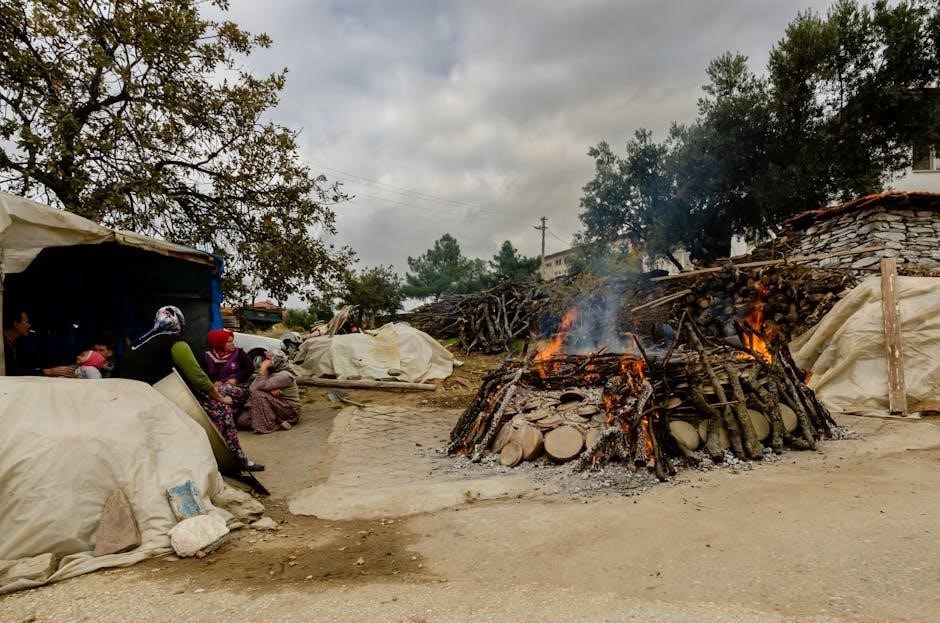Born in Blood and Fire by John Charles Chasteen is a concise history of Latin America, spanning six centuries and twenty nations. It explores cultural, political, and social evolution, offering insights into the region’s identity through colonization, revolution, and cultural blending. The fourth edition features updated analyses, a full-color design, and expanded visuals, making it a vital resource for understanding Latin America’s past and present.
Overview of the Book
Born in Blood and Fire by John Charles Chasteen offers a comprehensive and engaging narrative of Latin America’s history, spanning six centuries and twenty nations. The book explores pivotal events, influential figures, and cultural transformations that shaped the region’s identity. It delves into colonization, revolutions, and the blending of indigenous and European cultures. The fourth edition features a full-color design, enhanced maps, and illustrations, providing a visually rich experience. Chasteen’s work connects historical events to contemporary issues, making it a valuable resource for understanding Latin America’s past and its relevance to the present. This concise yet detailed overview is ideal for students and general readers seeking a holistic understanding of Latin American history and culture.
Author Background: John Charles Chasteen
John Charles Chasteen is a renowned historian specializing in Latin American studies. His work, particularly Born in Blood and Fire, reflects his deep understanding of the region’s complex history. Chasteen’s academic background and extensive research have equipped him to craft a narrative that seamlessly weaves together political, social, and cultural dynamics. His ability to present complex historical events in an accessible manner has made his writing widely acclaimed. Beyond Born in Blood and Fire, Chasteen has contributed to other scholarly works, further solidifying his reputation as a leading voice in Latin American historical studies. His contributions continue to influence both academic and general audiences interested in the region’s rich heritage.
Historical Significance of the Title
The title Born in Blood and Fire encapsulates the violent and transformative nature of Latin America’s history. It reflects the region’s birth through conquest, revolution, and struggle, shaping its identity. The phrase “blood” symbolizes the violence of colonization and the resilience of indigenous cultures, while “fire” represents the passion and upheaval of independence movements. This duality underscores the region’s complex legacy, where destruction and creation coexist. The title’s evocative imagery highlights the profound impact of historical events on Latin America’s cultural and political landscape, making it a fitting metaphor for the region’s enduring spirit and continuous evolution.
Historical Context of Latin America
Born in Blood and Fire explores Latin America’s history, spanning six centuries and twenty nations, highlighting colonization, revolutions, and cultural blending that shaped its identity and legacy.

Colonization and Its Impact
The arrival of European colonizers in Latin America reshaped the region’s trajectory, leading to profound social, economic, and cultural transformations. Indigenous populations faced displacement, exploitation, and violence, while new racial and social hierarchies emerged. The imposition of European systems disrupted traditional ways of life, creating a complex caste system that persists in some form today. Economic exploitation, particularly through resource extraction and labor, laid the foundation for long-term inequality. Despite resistance, colonization deeply influenced Latin America’s identity, blending indigenous, African, and European cultures. This period remains a critical lens for understanding the region’s historical development and its ongoing struggles with identity and inequality. The legacy of colonization continues to shape contemporary Latin America.
Key Revolutions in Latin American History
The 19th century witnessed transformative revolutions across Latin America, as nations sought independence from Spanish and Portuguese rule. The Spanish American wars of independence, led by figures like Simón Bolívar and José de San Martín, were pivotal in ending colonial dominance. These revolutions not only achieved political independence but also reshaped national identities and societal structures. However, the aftermath often led to political instability and social inequality, as new nations grappled with governance and economic challenges. These revolutions laid the foundation for modern Latin America, emphasizing the struggle for sovereignty and self-determination. Their legacy continues to influence contemporary political and cultural discourse across the region.
The Role of Indigenous Cultures
Indigenous cultures played a vital role in shaping Latin America’s identity and history. Despite colonization, native communities preserved their traditions, languages, and beliefs, contributing to the region’s rich cultural tapestry. Their resilience in the face of conquest and oppression underscored their enduring influence. Indigenous practices and knowledge, such as agricultural techniques and spiritual rituals, blended with European customs, creating unique syncretic traditions. These cultures also resisted colonial domination, often leading rebellions to protect their lands and identities. Their legacy remains central to Latin America’s modern identity, highlighting the region’s multicultural heritage and the ongoing struggle for indigenous rights and recognition.
Cultural Themes in the Book
The book explores themes of cultural blending, resistance, and identity, highlighting the complex interplay between indigenous traditions and European influences in shaping Latin America’s unique heritage.
The Encounter: Indigenous and European Perspectives
The book vividly portrays the transformative encounter between Indigenous peoples and European colonizers, exploring their contrasting worldviews, cultural practices, and responses to conquest. Indigenous societies, with their rich traditions and communal structures, faced unprecedented disruption. Europeans, driven by religious, economic, and political motives, imposed their systems, often violently. This clash of perspectives led to profound cultural, social, and spiritual changes. The encounter was marked by both resistance and adaptation, shaping the complex identity of Latin America. Chasteen highlights how Indigenous voices and agency persisted despite colonial dominance, influencing the region’s cultural fabric. This chapter underscores the enduring legacy of this pivotal historical moment.
Colonial Society: Structure and Hierarchy
The colonial society in Latin America was rigidly structured, with a clear hierarchy dominated by European colonizers. At the top were the peninsulares (Spaniards born in Europe), followed by criollos (Spanish-Americans). Below them were mestizos (mixed Indigenous and European descent), Indigenous peoples, and at the bottom, enslaved Africans. This hierarchy was enforced through laws and social norms, perpetuating inequality and exploitation. The colonial economy relied on systems like the hacienda and encomienda, which exploited Indigenous labor. The Catholic Church also played a central role, legitimizing the colonial order. This structure deeply influenced social, economic, and racial dynamics, shaping the legacy of inequality that persists in Latin America today. Chasteen examines how this hierarchy was both contested and reinforced over time.
Cultural Blending: The Birth of New Identities
Cultural blending in Latin America emerged from the intersection of Indigenous, European, and African traditions, creating unique identities. This process, explored in “Born in Blood and Fire,” was marked by the fusion of languages, religions, and customs; Indigenous practices merged with Catholicism, while African rhythms infused music and dance. The rise of mestizaje (mixed heritage) symbolized this blending, challenging rigid colonial hierarchies. Over time, these interactions shaped distinct cultural practices, from art to cuisine, reflecting resilience and creativity. Chasteen highlights how this blending not only enriched Latin American culture but also became a source of identity and pride, transcending the divides of conquest and oppression.
Key Events and Figures
The book highlights pivotal events like Latin America’s wars of independence and influential figures such as Simón Bolívar, who shaped the region’s liberation from colonial rule.
Major Historical Events Shaping Latin America
The book delves into transformative events like the Latin American wars of independence, the Mexican Revolution, and the Cuban Revolution, which reshaped the region’s political and social landscapes. These upheavals were driven by resistance to colonial rule, economic inequality, and the quest for sovereignty. The wars of independence in the early 19th century led to the collapse of Spanish and Portuguese rule, while the Mexican Revolution addressed land reform and class struggles. The Cuban Revolution, with its socialist ideals, had far-reaching impacts on Cold War geopolitics. These events, marked by bloodshed and conflict, laid the foundation for modern nation-building and identity formation in Latin America.
Influential Leaders in Latin American History
The book highlights key figures who shaped Latin America’s destiny, such as Simón Bolívar, a unifying force behind independence movements, and José de San Martín, who led Argentina, Chile, and Peru to freedom. Che Guevara and Fidel Castro are prominent for their roles in the Cuban Revolution, advocating for socialism. Other leaders like Benito Juárez in Mexico and Eva Perón in Argentina left lasting legacies in politics and social reform. These individuals, driven by vision and often controversy, influenced the region’s struggle for sovereignty and identity. Their stories illustrate the complex interplay of ideals, power, and transformation in Latin America’s history.
The Role of Religion in Shaping Society
Religion, particularly Catholicism, played a central role in shaping Latin American society, as explored in Born in Blood and Fire. The Catholic Church, introduced by Spanish and Portuguese colonizers, became a powerful institution, influencing culture, education, and social hierarchies. Missionaries often served as intermediaries between indigenous populations and colonial authorities, though their efforts sometimes perpetuated exploitation. The Church’s teachings reinforced colonial structures while also providing a moral framework for resistance. Over time, religious practices blended with indigenous traditions, creating a unique cultural synthesis. The book highlights how religion both upheld and challenged oppressive systems, leaving a lasting legacy in Latin America’s identity and social dynamics.

Modern Latin America

Modern Latin America grapples with cultural identity, social inequality, and economic transformation, blending tradition with globalization, as explored in Born in Blood and Fire.
Contemporary Cultural Analysis
Modern Latin America’s cultural identity is shaped by its complex history, blending indigenous traditions, European influences, and African heritage. Born in Blood and Fire highlights how contemporary societies navigate globalization while preserving cultural roots. Urbanization and migration have transformed social dynamics, creating vibrant yet divided communities. The book explores themes of resilience and adaptation, emphasizing how cultural expressions like music, art, and literature reflect these changes. Issues of identity, race, and class remain central, influencing political and social movements. By examining these elements, Chasteen provides a nuanced understanding of Latin America’s cultural evolution, offering insights into its rich, multifaceted heritage and ongoing struggles.
Political and Social Challenges Today
Latin America faces significant political and social challenges, including corruption, inequality, and political instability. Many countries struggle with weak governance, which undermines public trust and hinders development. Social inequality persists, with disparities in education, healthcare, and economic opportunities. Violence and crime, often linked to drug trafficking, remain pervasive issues. Additionally, the region grapples with the impacts of globalization and economic policies that have widened the gap between the rich and the poor. These challenges are further complicated by environmental concerns and migration crises. Addressing these issues requires comprehensive reforms and regional cooperation to ensure sustainable progress and social justice.
Economic Transformations and Globalization
Latin America has undergone significant economic transformations driven by globalization. The region has shifted from colonial economies based on agriculture and resource extraction to more diversified modern economies. Globalization has integrated Latin America into the global market, fostering trade, investment, and technological advancement. However, this integration has also led to inequality, with some nations prospering while others struggle with poverty and underdevelopment. The rise of manufacturing in countries like Mexico and Brazil contrasts with commodities-dependent economies facing volatility. International institutions and trade agreements have shaped economic policies, opening markets but also sparking debates over sovereignty and environmental impact. These changes highlight the complex interplay between globalization and regional development.
The Book’s Structure and Content
“Born in Blood and Fire” is structured chronologically, spanning pre-Columbian times to modern Latin America, focusing on colonialism, independence, and modernization. It blends history with cultural insights, offering a comprehensive narrative of the region’s transformation, covering 20 countries and emphasizing the intersection of social, political, and economic developments.
Chronological Narrative Approach
The book employs a chronological narrative approach, tracing Latin America’s history from pre-Columbian civilizations through colonial rule, independence movements, and modernization. This structure allows readers to follow the region’s evolution over time, understanding how historical events shaped its cultural, political, and social landscapes. By organizing content chronologically, Chasteen provides a clear and logical flow, making complex historical processes accessible. The narrative seamlessly transitions from the indigenous empires of the Aztecs and Incas to the arrival of European colonizers, then through the turbulent 19th-century wars of independence and into the 20th century’s struggles with identity and development. This approach helps readers grasp the continuity and change that define Latin America’s rich history.

Geographical Scope: Twenty Nations Covered
The book provides a comprehensive overview of Latin America by covering twenty nations, showcasing the region’s vast geographical and cultural diversity. From the sprawling nations of Brazil and Mexico to smaller countries like Uruguay and Belize, Chasteen’s narrative spans the entire region. This broad scope allows readers to explore the shared historical experiences and unique national identities that define Latin America. The inclusion of Central America, the Caribbean, and South America ensures a holistic understanding of the region’s complexity. By examining these twenty nations, the book highlights both the common themes and the distinct trajectories that have shaped Latin America’s history, offering a balanced and inclusive perspective.
Key Factors: Colonization, Revolution, and Culture
The book delves into three pivotal factors that shaped Latin America: colonization, revolution, and culture. Colonization introduced profound changes, including the exploitation of resources, the imposition of European systems, and the blending of cultures. Revolution, both political and social, played a central role in shaping national identities and fighting for independence. Culture, as a unifying and dividing force, reflects the region’s rich diversity, blending indigenous, African, and European influences. These factors interweave to create a complex tapestry, offering insights into the historical and contemporary dynamics of Latin America. Chasteen’s narrative seamlessly connects these elements, providing a nuanced understanding of the region’s transformation over time.

Editions and Updates
“Born in Blood and Fire” has undergone several editions, each refining its historical narrative. The fourth edition includes updated research, expanded coverage of key events, and enhanced readability, ensuring a comprehensive understanding of Latin America’s past and present.
Fourth Edition Enhancements
The fourth edition of Born in Blood and Fire introduces significant enhancements, offering a fresh perspective on Latin America’s history. Updated research incorporates the latest scholarly findings, ensuring accuracy and relevance. The narrative has been refined for clarity, making complex historical events more accessible to readers. New primary sources and firsthand accounts enrich the storytelling, providing deeper insights into the lives of ordinary people and influential figures. Additionally, the edition includes expanded coverage of gender, race, and social movements, highlighting their pivotal roles in shaping the region’s identity. These enhancements create a more comprehensive and engaging exploration of Latin America’s past, making the book indispensable for both students and enthusiasts of history.
Visual and Design Improvements
The fourth edition of Born in Blood and Fire features notable visual and design improvements, enhancing readability and engagement. High-resolution maps and illustrations provide clearer geographical and historical context, while a refined color scheme and typography improve the overall aesthetic. The layout has been optimized for better navigation, with subheadings and captions standing out to guide readers. Expanded use of images, including historical photographs and artwork, offers a more immersive experience. These visual enhancements complement the text, making complex historical narratives more accessible and visually appealing for both students and general readers. The redesigned interior reflects a modern approach to historical storytelling.
Expanded Map and Illustration Program
The fourth edition of Born in Blood and Fire boasts an expanded map and illustration program, significantly enriching the reader’s understanding of Latin America’s history. New and detailed maps highlight key geographical features, empires, and modern nation-states, providing clarity on historical events and cultural developments. Illustrations now include more historical images, such as colonial art, photographs of leaders, and cultural artifacts, offering visual context to the narrative. The program enhances the book’s educational value by making complex historical and cultural themes more accessible. These visual additions, alongside improved captions, create a more engaging and informative reading experience, helping readers better connect with the region’s rich and diverse history.

Reception and Impact

Born in Blood and Fire is widely praised for its engaging narrative and comprehensive coverage of Latin American history, making it a popular choice for courses and readers seeking deeper understanding of the region’s past. Its accessible style and thorough research have solidified its reputation as a foundational text in the field, influencing both academic and general audiences. The book’s ability to weave together political, social, and cultural history has made it a cornerstone of Latin American studies, fostering a broader appreciation for the region’s complex heritage. Its impact continues to grow with each new edition.
Academic and Reader Reviews
Born in Blood and Fire has garnered widespread acclaim for its meticulous research and compelling narrative. Scholars praise its ability to balance depth with readability, making it accessible to both students and general readers. The book’s nuanced exploration of Latin America’s complex history has earned it a reputation as a seminal work in the field. Readers frequently highlight its engaging storytelling and the author’s skill in weaving together political, social, and cultural threads. Many consider it essential reading for understanding the region’s past and its contemporary implications. The book’s popularity endures, with each edition receiving positive reviews for its updated content and insights.
Use in Educational Curricula
Born in Blood and Fire is widely adopted in educational curricula due to its comprehensive and engaging narrative. It is frequently used in Latin American history courses at both undergraduate and graduate levels. The book’s chronological structure and clear explanations make it accessible for students. Educators appreciate its balanced perspective, which incorporates political, social, and cultural dimensions. Many universities include it in their syllabi for its ability to stimulate critical thinking and discussions. The text is often paired with primary sources and multimedia resources to enhance learning; Its popularity in classrooms underscores its value as a foundational text for understanding Latin America’s complex history and its relevance to contemporary issues.
Influence on Latin American Studies
Born in Blood and Fire has profoundly shaped the field of Latin American studies, offering a nuanced and accessible narrative of the region’s history. Its synthesis of political, social, and cultural dynamics has influenced scholarship, encouraging interdisciplinary approaches. The book’s emphasis on the interconnectedness of historical events and contemporary issues has inspired new research directions. It remains a foundational text for scholars and students, fostering a deeper understanding of Latin America’s complexities. By bridging gaps between academic and general audiences, it has contributed to a broader appreciation of the region’s rich and multifaceted heritage, solidifying its role as a cornerstone in Latin American historical studies.

Additional Resources and Related Works
Explore related books like Latin America: A New Historical Narrative and online resources such as the Latin American Studies Association website for deeper insights.
Recommended Reading for Further Study
For a deeper understanding of Latin America’s history, consider Open Veins of Latin America by Eduardo Galeano, which explores economic exploitation and cultural identity. Another essential read is The Labyrinth of Solitude by Octavio Paz, offering philosophical insights into Mexico’s cultural landscape. Additionally, The Economic History of Latin America since Independence by Victor Bulmer-Thomas provides a comprehensive analysis of the region’s economic development. These works complement “Born in Blood and Fire” by offering diverse perspectives on colonialism, culture, and modern challenges, enriching your exploration of Latin America’s rich and complex heritage.
Translations and Other Works by the Author
John Charles Chasteen’s “Born in Blood and Fire” has been translated into multiple languages, including Spanish and Portuguese, to reach a broader audience across Latin America and beyond. These translations ensure the book’s insights into the region’s history are accessible to Spanish and Portuguese-speaking readers. Additionally, Chasteen has authored other significant works, such as “The Ghost of Freedom: A History of the Caucasus,” which explores the historical complexities of a different region, and “National Rhythms, African Roots: The Deep History of Latin American Popular Dance,” delving into the cultural dimensions of Latin America. His diverse scholarship underscores his expertise in historical narratives and cultural analysis, enriching the understanding of Latin America’s past and its global connections.
Online Resources for Latin American History
Several online resources complement the study of Latin American history, offering deeper insights into the themes explored in “Born in Blood and Fire;” Digital archives like the Latin American Network Information Center (LANIC) provide extensive primary sources and research materials. Academic databases such as JSTOR and Project MUSE offer access to scholarly articles on the region’s history. The Library of Congress features digitized collections, including rare documents and maps. Online platforms like Khan Academy and Coursera host courses and lectures on Latin American history. Additionally, websites like Google Arts & Culture showcase interactive exhibits on Latin America’s cultural heritage, while open-access journals like Latin American Research Review provide cutting-edge research. These resources enrich the understanding of the region’s complex past and its ongoing evolution.
“Born in Blood and Fire” by John Charles Chasteen is a seminal work that reshapes understanding of Latin America’s history, culture, and identity, leaving a lasting academic legacy.

Legacy of “Born in Blood and Fire”
John Charles Chasteen’s Born in Blood and Fire has left an indelible mark on Latin American historical studies. Its comprehensive narrative and accessible style have made it a foundational text for both scholars and students. The book’s ability to weave together complex historical events, cultural transformations, and social dynamics has set a new standard for historical storytelling. Its influence extends beyond academia, shaping public understanding of Latin America’s rich and often tumultuous past. The fourth edition’s enhancements, including updated research and visual elements, ensure its continued relevance. As a result, Born in Blood and Fire remains a cornerstone of Latin American studies, inspiring future generations of historians and readers alike. Its legacy underscores the importance of understanding the region’s history to grasp its contemporary identity and challenges.
Final Thoughts on the Book’s Contribution
Born in Blood and Fire has profoundly enriched the understanding of Latin America’s complex history and cultural identity. Its engaging narrative and meticulous research have made it a vital resource for educators and enthusiasts alike. By bridging the gap between academic scholarship and accessible storytelling, Chasteen’s work has inspired a deeper appreciation for the region’s diverse heritage. The book’s emphasis on the interplay between colonization, revolution, and cultural blending provides a holistic perspective that is both informative and thought-provoking. Its contribution lies in its ability to illuminate the past while resonating with contemporary discussions about identity, power, and transformation, ensuring its enduring relevance in the study of Latin America.
Future of Latin American Historical Studies
The future of Latin American historical studies is poised for innovation, building on the foundational works like Born in Blood and Fire. Advances in digital scholarship and interdisciplinary approaches will likely dominate, offering new ways to explore the region’s history. The integration of technology, such as digital archives and virtual reality, could make historical narratives more immersive and accessible. Additionally, there may be a greater emphasis on environmental history and the intersection of sustainability with historical processes. Collaborations between historians and experts from other fields, like anthropology and economics, will deepen our understanding of Latin America’s past and its relevance to global challenges.